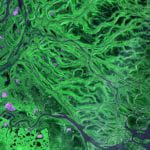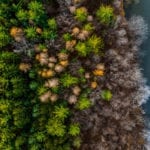The transition of leaf colour from the greens of the growing season to the mosaic of green, yellow, and red in autumn is a wonder to recreational “leaf peepers” and the driver of billions of dollars in tourism in northeastern North America and beyond. The biology behind the initial transition of leaves from green to yellow is well known—shorter days and cooler temperatures in late summer and early fall trigger the reduced production and increased breakdown of green chlorophyll, the pigments that help plants capture the sun’s light energy to make sugars (i.e., photosynthesis). This gradual loss of green colour reveals yellow carotenoid pigments that were in the leaves all along but were masked by the more visible chlorophylls. Yellow carotenoid pigments help chlorophyll capture light energy and also protect leaves from light damage.
However, in at least some trees, an additional change in colour can occur in fall—a reddening of leaves following the production of the pigment anthocyanin. It has long puzzled plant biologists why trees would produce a new pigment in leaves that are about to senesce and die. After all, why use precious and potentially scarce sugar resources (that might otherwise be reabsorbed into stems and used for growth the following season) to build new red pigments?
Producing new red pigments in leaves: a balancing act?
There have been a surprisingly large number of hypotheses about the potential ecological benefits of producing new anthocyanin pigments in senescing leaves. From a physiological perspective, the most common explanation is grounded in the idea of protection against external stressors such as cold, drought, ozone, UV radiation, or pest and pathogen exposure. Anthocyanins are generated following exposure of the plant to a range of stressors, and anthocyanins have various biochemical properties (e.g., as a chemical antifreeze agent and a powerful antioxidant) that may help leaves better survive stressors. By fighting the stressors that shorten leaf lifespan, it is thought that anthocyanins provide leaves with more time to accumulate precious sugars and potentially limited nutrients (e.g., nitrogen) and more time to transport these sugars/nutrients before senescing and falling from the tree. Thus, the benefits of anthocyanins to prolong sugar and nutrient resorption could outweigh the energetic “costs” of producing anthocyanins.
Exploring the role of low-temperature exposure
Although there are many stressors that can trigger anthocyanin production, most, like pest and pathogen outbreaks, occur at a localized geographic scale and would not account for the gradual, region-wide expression of reds that are typical in places such as northeastern North America. In contrast, throughout northeastern North America temperatures cool as autumn progresses and this temperature change could better account for the timing and spatial pattern of red colour expression typically seen across the landscape. We proposed a physiological mechanism whereby low-temperature exposure could trigger anthocyanin production in leaves. Sugars move to different parts of a plant via phloem tissue, and a buildup of sugars in the leaves causes production of anthocyanin. We hypothesized cold-induced slowing of phloem transport would allow sugars to build up in leaves leading to anthocyanin production.
In our study published in the Canadian Journal of Forest Research, we tested this proposed mechanism by cooling individual branches of a sugar maple tree using a unique refrigeration system. This branch cooling system experimentally reduced phloem temperatures on treated branches relative to adjacent non-cooled (control) branches.
Branch cooling resulted in a buildup of sugars in the leaves, indicating slowed phloem transport, and triggered anthocyanin production. We found dramatic increases in leaf sugar and anthocyanin concentrations; leaves from cooled branches had 2–9 fold more sugar and anthocyanin and were more red in colour compared to leaves distal to the refrigeration system.

Branch cooling system (left). Leaves (right) from cooled branches (top) and branches that weren’t cooled (left bottom).
To our knowledge, this study was the first to experimentally manipulate phloem temperatures on intact tree branches in autumn and highlights the biochemical responses of leaves and branches when exposed to low temperatures. Although this study was conducted at the branch level, we propose that this same stimulus and response could help explain landscape-level foliar anthocyanin displays across time and space. A better knowledge of the physiology of anthocyanin production could help scientists and managers better predict the timing, intensity, and location of fall colour displays so cherished by the public.




